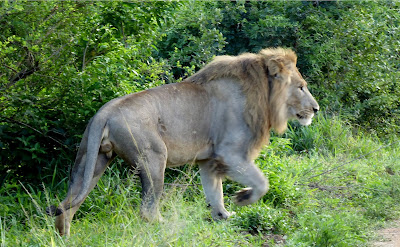Let's get the hard part about Hluhluwe game park out of the way first. It is pronounced something close to Shlu-Shlu-Hee and which Google translates to "scratched". The park is actually two connected parks Hluhluwe and Imfolozi. Combined they are about 235,000 acres.
The landscape is generally light to heavy bush, with rolling hills, interrupted by the occasional stream and some big rivers.No shortage of Cape Buffalo. The males have the massive center part of their horns that look like their brains are overflowing. You see many single and small groups of old males. They are called Duggers. As the males get older they get kicked out of the breeding herd and spend their retirement years wallowing around a mud hole till a lion or hyena decides they are easy picking for a snack.
Might as well put up the Lion pictures now in case our reader doesn't get any further in this post. We were really lucky to come across this pride of lions as our guide drove the back roads of the reserve.
I don't usually post videos, but here's a short one of the young lions vocalizing.
A kite
These are Dung Beetles rolling the dung ball they made from elephant poop down the road. It is fascinating to see them frantically work together to roll this ball that is ten times their size.
Some type of Monitor Lizard
These are Weaver Bird nests. They are built by the yellow male. His potential partner then goes inside to inspect. If all is good then there is marital bliss. If she rejects the nest the male tears it apart and rebuilds for another try.
A Terrapin working his way out of the water
A Baboon troop blocking the road. The males are big and really look like they mean business.
Cape Buffalo carcass, probably taken down by a lion.
A giraffe wondering why we are walking by his turf.
We were stopped along the road by this heard of Cape Buffalo. While waiting for them to move we saw the heard spread out a bit and this large White Rhinoceros started strolling our way, with a baby by her side you can just see.
Once Mom turned side ways we could see this baby Rhino walking through the herd too.
Guinea fowl
Some very young wobbly Impala babies
This guy has a lot of horn to protect from the poachers
Baby Warthogs -- what else needs to be said?
Warthogs are just not so cute when they get older
Steppe Buzzard
Taking off for a snack
We stopped along the side of the road when we started seeing these groups of Vultures on the tree tops on one of the game dirves. Our guide said there must be a new kill somewhere close, maybe a lion kill.
After hunting the hillsides with our binoculars we found this fairly fresh Rhino carcass. Not sure if it was natural causes or a poacher's doing, but not lions. You can see the first team of Vultures doing the preliminary work on the carcass. It will be picked clean by the next day.
A male impala with impressive antlers
Helpful suggestions from the park
Carrying our bags to the front door of our room at Hluhluwe Hilltop Lodge. If you look close on the right hand side you can see a large, male Nyala sitting in the shrubs and watching me move in.
Another hours old Impala
Black(?) Kite
Another Vulture in the cleanup crew
A widdah bird. This male has grown his oversized tail for showing off during mating season. When they fly with this tail it looks like they can barely stay airborne.
Hluhluwe has elephants, but they were clearly more cautious of vehicles than in Thula Thula park we were in earlier.
.
Enough of the animal show and tell from Hluhluwe for today.
Paul







































COOL...! Once in a lifetime
ReplyDelete